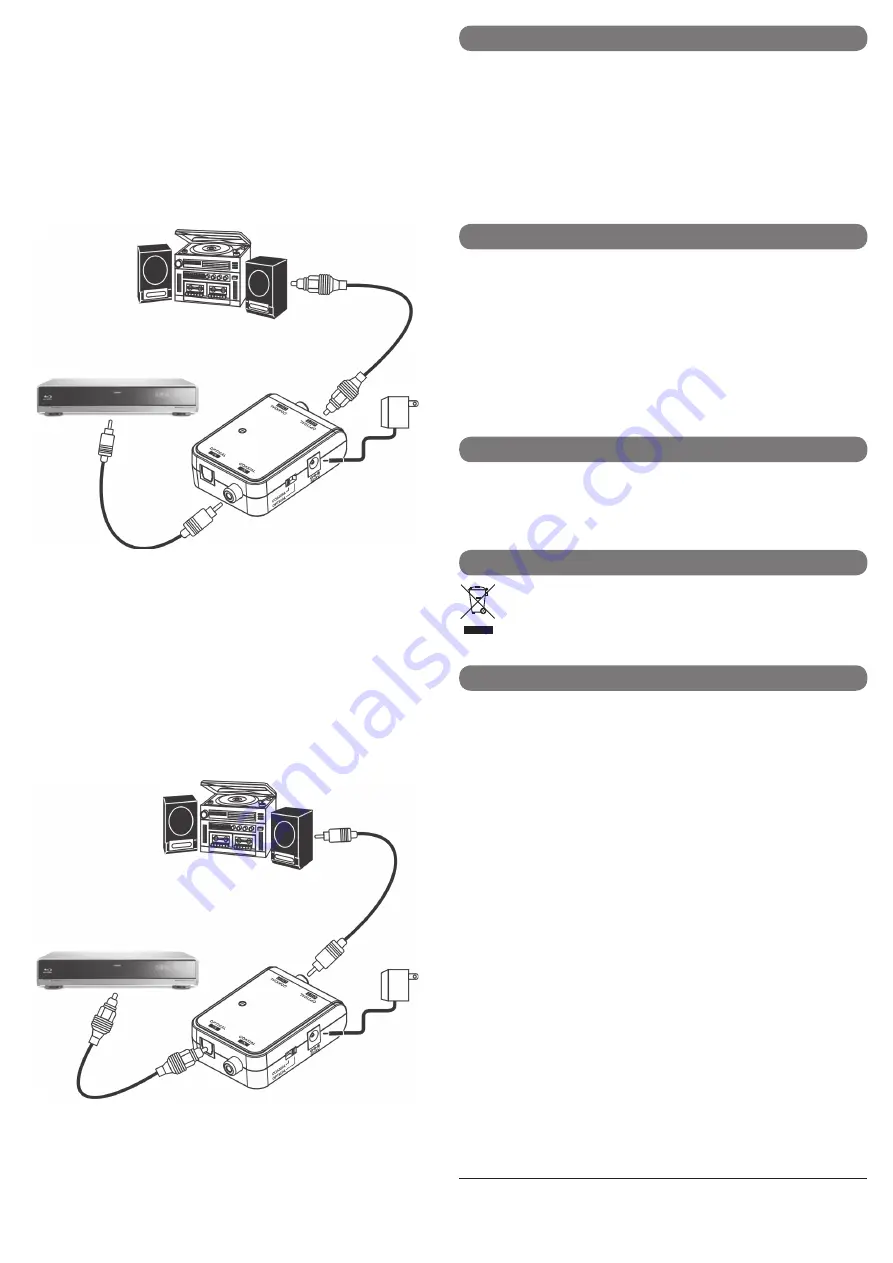
Converting coaxial signal into optical signal
• Connect the coaxial output of your source device (e.g. Blue Ray-Player) with the COAXIAL
IN connector (2).
• Connect the OPTICAL OUT connector (5) with the optical input of the subsequent device
(e.g. digital amplifier).
• Slide the input selector switch (3) to the Coaxial position.
• Plug the low voltage plug from the power unit in the power supply connection (4).
• Plug the power adaptor into a wall socket.
• As soon as the audio converter is supplied with power, the power indicator (7) is lit.
• Select the input of the target device (e.g. digital amplifier) from the corresponding digital
input.
Converting optical signal into coaxial signal
• Connect the optical output of your source device (e.g. Blue Ray-Player) with the OPTICAL IN
connector (1).
• Connect the COAXIAL OUT connector (6) with the coaxial input of the subsequent device
(e.g. digital amplifier).
• Slide the input selector switch (3) in the OPTICAL position.
• Plug the low voltage plug from the power unit in the power supply connection (4).
• Plug the power supply into a wall socket.
• As soon as the audio converter is supplied with power, the power indicator (7) is lit.
• Select the input of the target device (e.g. digital amplifier) from the corresponding digital
input.
Handling
• Never operate the audio converter or the power unit with damaged housing or missing covers.
• Never use the product immediately after it has been brought from a cold room into a warm
one. The condensation that forms might damage the product. Leave it until it has reached
room temperature. Wait until the condensation has evaporated.
• Never unplug the power unit from the mains socket by pulling on the cable; always use the
provided handles which are intended specifically for this purpose.
• Unplug the power supply if you are not going to use the device for a while.
• For safety reasons, always disconnect the power unit from the mains socket during thunder-
storms.
Troubleshooting
The power indicator (7) will not light up:
• Is the low voltage plug of the power unit correctly inserted in the power connection (4)?
• Check the mains socket. Will it be supplied with power?
The power indicator (7) lights up, but signal conversion is not possible:
• Are the source device and target device plugged into the correct ports?
• Is the input selector switch (3) in the correct position? It must always be in the position where
the input signal is.
• Is the correct input selected on the target device?
• Is one of the signalling lines broken or damaged? Try according to possibility a different line.
Maintenance and Care
The product does not have to be serviced and, except for occasional cleaning with a soft, dry
cloth, requires no maintenance whatsoever.
Never use aggressive cleaning agents or chemical solutions as these may damage the sur-
faces.
Disposal
Electronic devices are recyclable and must not be disposed of in the household
waste!
When it is no longer of use, please dispose of the product according to the applica-
ble statutory requirements.
Technical Data
Operating voltage ................. 100-240 V/50/60 Hz (power supply)
5 V/DC (Audio Converter)
Power consumption .............. 0.1/0.9 W (Standby/max.)
Inputs .................................... 1 x coaxial (RCA)
1 x optical (TOSLINK)
Outputs ................................. 1 x coaxial (RCA)
1 x optical (TOSLINK)
Signal format ........................ S/PDIF (Sony/Philips Digital Interface)
Dimensions ........................... 79 x 51 x 25 mm
Weight .................................. 45 g
.
This is a publication by Conrad Electronic SE, Klaus-Conrad-Str. 1, D-92240 Hirschau (www.conrad.com).
All rights including translation reserved. Reproduction by any method, e.g. photocopy, microfilming, or the capture in electronic data
processing systems require the prior written approval by the editor. Reprinting, also in part, is prohibited. This publication represent the
technical status at the time of printing.
© Copyright 2014 by Conrad Electronic SE.








